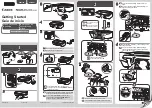
Programming Codes
T480
Programmer’s Guide
Page
58
Rev A
100-14362
User Defined characters
[ESC] =
Define user-defined characters
ASCII
[ESC] = <y> <c
1
> <c
2
> [<x
1
> <d
1
> … d(y
x
x
1
)] … [<x
k
> <d
1
> … d (y
x
x
k
)]
Hexadecimal
1BH 3DH <y> …
Decimal
<27> <51> <y> …
Range
y = 2 or 3
32
c
1
c
2
255
0
x
24 font character width
0
d
1
… d (y
x
x)
255
IPCL
none
Description:
The [ESC] = <y> <c
1
> <c
2
> [<x
1
> <d
1
> … d(y
x
x
1
)] … [<x
k
> <d
1
> … d (y
x
x
k
)] command defines user-defined characters from character code <c
1
> to <c
2
>. <y>
and <x> are the configurations of a user-defined character. <y> specifies the number of
bytes in the vertical direction. <x> specifies the number of bytes in the horizontal
direction. Character code ranges from 32 (20H) to 255 (FFH) can be defined by <c
1
>
and <c
2
>
.
Up to 223 user-defined characters can be defined. Data (<d>) specifies a bit
printed to one and not printed to zero. At the default, user-defined characters are not
defined and the internal character set is printed. Once the user-defined characters have
been defined, they are available until [ESC] $ is executed; the user-defined characters
are redefined; the power is turned off; or the printer is reset.
Note:
User defined are bit ages and are not scalable. It is intended that
user defined characters be defined using a custom true type font. That
font may then be selected by the user’s application.
[ESC] $
Cancel user-defined characters
ASCII
[ESC] $
Hexadecimal
1BH 24H
Decimal
<27> <36>
IPCL
none
Description
The [ESC] $ command removes all user-defined characters from the
printer’s memory. After the user-defined characters are canceled, the internal character
set is printed.
[ESC] >
Enable user-defined characters
ASCII
[ESC] > <n>
Hexadecimal
1BH 3EH <n>
Decimal
<27> <62> <n>
Range
<0>, <1>, 0, or 1
1 Enables the characters
0 Disables the characters
IPCL
none
Description
The [ESC] > <n> command enables or disables the user-defined
characters. The internal character set is printed.
















































